Old World monkeys are a diverse group of primates that are indigenous to Africa and Asia. They are larger in size, have more complex social structures, and longer snouts than New World monkeys.
Old World monkeys include species such as macaques, baboons, and langurs. While Old World monkeys inhabit Africa and Asia, there is evidence to suggest that their true origins are in Africa.
You are reading: 10 Types Of Old World Monkeys
The basis of this belief is that most Old World monkey species live in Africa. Also, the African species tend to be more closely related to each other than to Asian species.
Old World monkeys’ social structures comprise groups of multiple families, often including both males and females. In contrast, New World monkeys typically build smaller groups consisting of a single-family unit.
In this article, we will explore 10 types of Old World monkeys, including their characteristics, habitats, and behaviors.
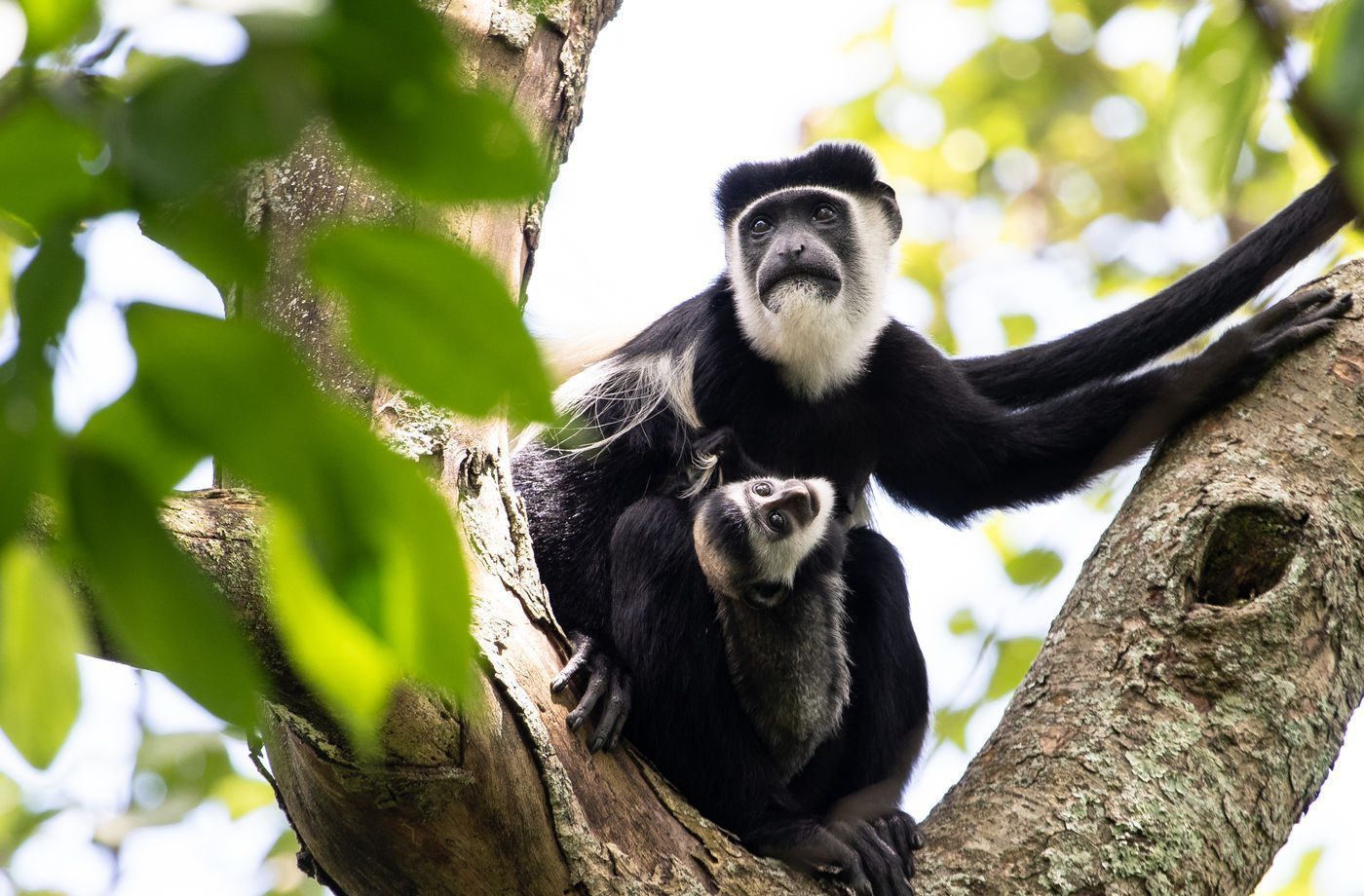
10 Types Of Old World Monkeys
Patas Monkey
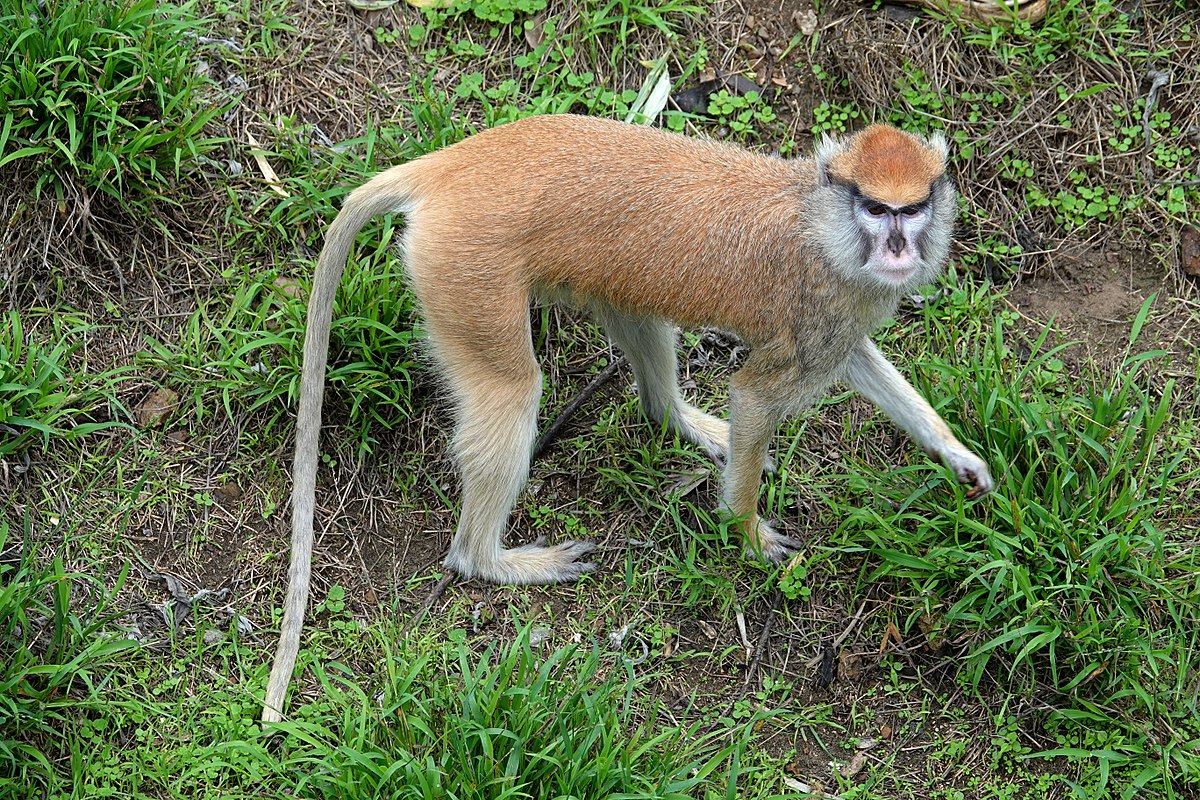
Patas monkey (Erythrocebus patas) is a medium-sized terrestrial monkey that is native to Africa. They are known for their long legs, which make them the fastest primates, capable of running up to 55 km/hr (34 mi/hr).
Patas monkeys are omnivorous, and their diet consists mainly of fruits and insects but also includes leaves, roots, and bird eggs. They are found in open country, mainly in savanna and woodland habitats since they are predominantly terrestrial.
They are typically found in grass savanna, dry and dense woodlands with tall grass, and on grass steppe with thicket clumps. Patas monkeys live in multi-female groups of up to 60 individuals, consisting of a single dominant male and multiple females with their offspring.
Guenon
Guenons are a group of small to medium-sized monkeys that are widespread throughout the tropical rainforest belt in Africa to the south of the Sahara Desert. They are arboreal primates, meaning they spend most of their time living in trees.
Guenons live in different types of forests, including floodplain forests, woodlands, and wetlands. They are active during the daytime and spend their time looking for food in the morning and late afternoon.
While foraging, they communicate with each other through a series of peaceful calls. If a member of the troop encounters a dangerous situation, they emit a sharp barking sound, which is repeated by others.
Guenons are unique in that they have a wide range of vocalizations, which they use to communicate with each other. There are over 25 species of guenons, and they are known for their colorful fur patterns, which vary between species.
Kipunji
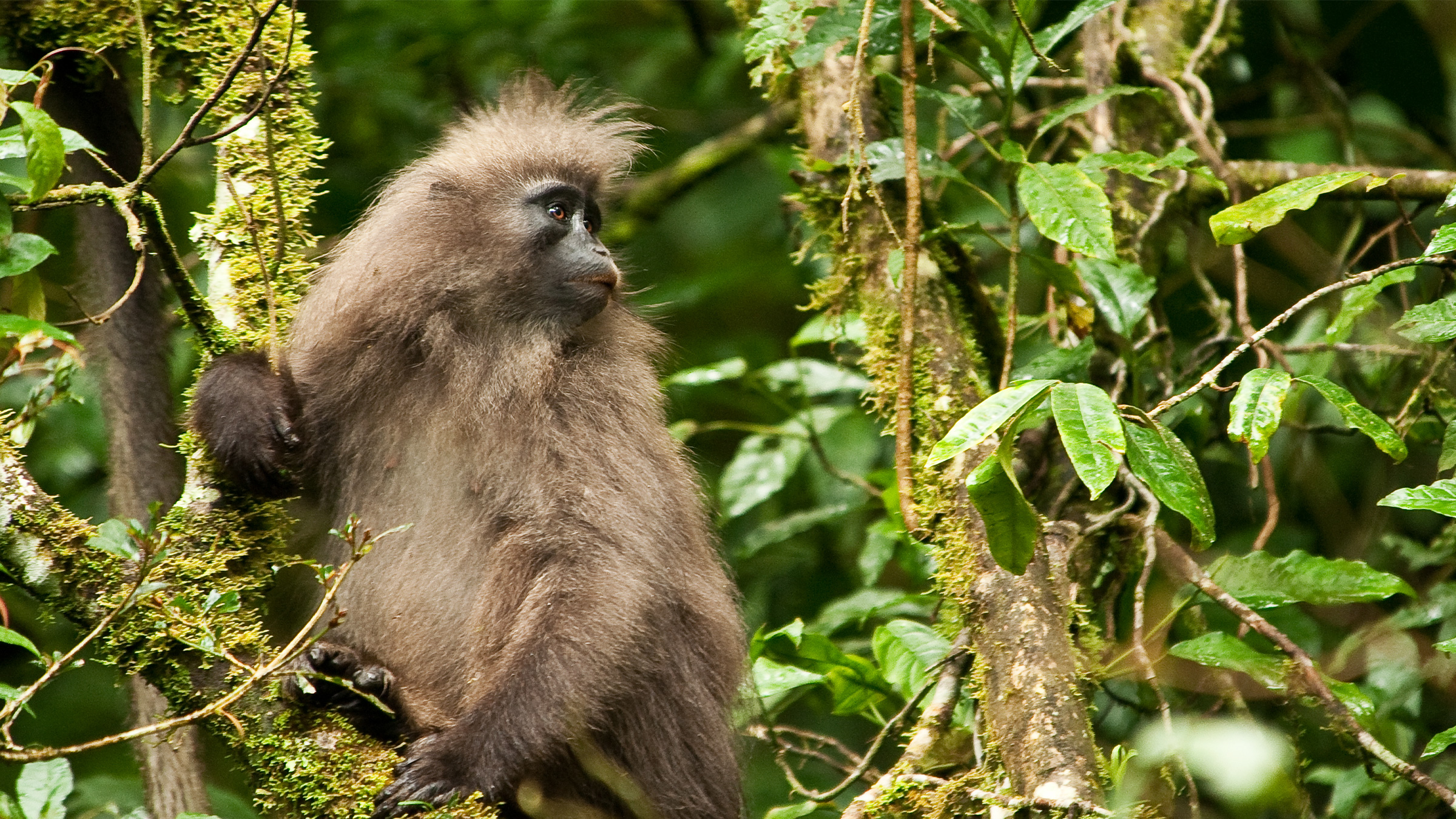
The kipunji, also known as the highland mangabey, is a species of Old World monkey that lives in the highland forests of Tanzania. The kipunji has a unique call, described as a ‘honk-bark’, which distinguishes it from its relatives, the grey-cheeked mangabey and the black crested mangabey, whose calls are described as ‘whoop-gobbles’.
The kipunji is a large monkey that can reach up to 35 inches (90 cm) in length and typically weighs between 22 and 35 pounds (10–16 kg). Adult male kipunjis have been observed at a typical length of 85 to 90 cm and are estimated to weigh between 10 and 16 kg.
The kipunji’s relatively long pelage is light or medium brown with white on the end of the tail and the ventrum. The pelage close to the hands and feet tends to be a medium to dark brown.
Its hands, feet, and face are all black. The kipunji is classified as an endangered species by the IUCN, and its range is restricted to just 6.82 mi2 (17.7 km2) of forest in the two isolated regions, the Ndundulu forest and the Rungwe-Livingstone forest.
White-Eyelid Mangabey
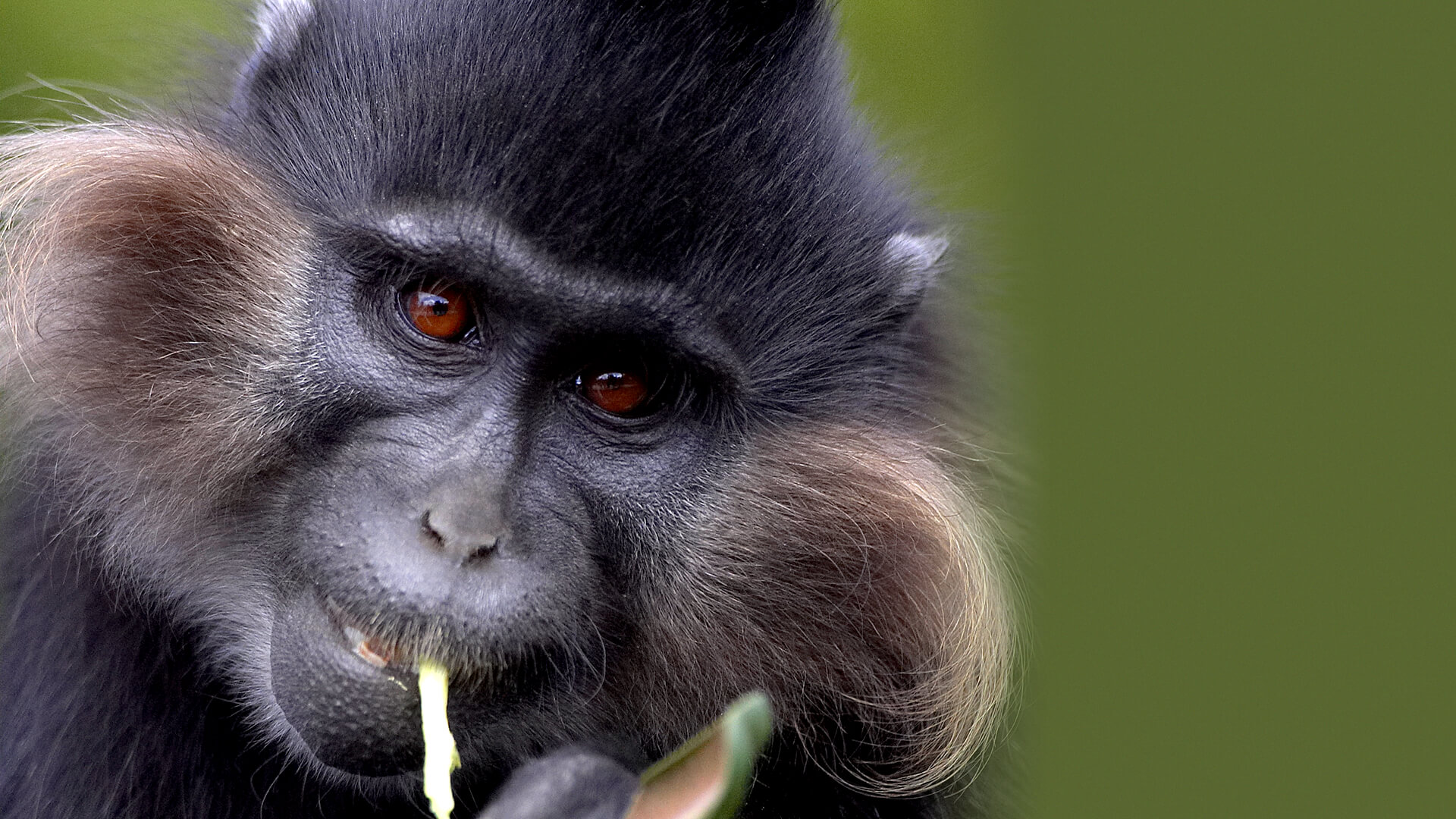
The white-eyelid mangabey is an Old World monkey that belongs to the genus Cercocebus and is native to Africa. They are characterized by their bare upper eyelids, which are lighter than their facial skin coloring, and the uniformly colored hairs of their fur.
There are several species of mangabeys, including the agile mangabey, collared mangabey, and golden-bellied mangabey, among others. White-eyelid mangabeys are comfortable both in trees and on the ground, and they travel on their hands and feet between patches of forest or to forage in the leaf litter.
They communicate with each other through a variety of vocalizations, including shrieks, whoops, chuckles, and grunts, as well as flashing their white eyelids with other facial gestures. White-eyelid mangabeys are found in different types of forests, including rainforests and mangrove swamps in Western Africa.
Black-and-White Colobus
The black-and-white colobus is an Old World monkey of the genus Colobus, native to Africa. There are five species of this monkey, and at least eight subspecies. They are generally found in high-density forests where they forage on leaves, flowers, and fruit.
The black-and-white colobus has glossy black fur that strongly contrasts with the long white mantle, whiskers, and beard around the face and bushy white tail.
The Eastern black-and-white colobus is distinguishable by a U-shaped cape of white hair running from the shoulders to lower back, whereas the Angolan black-and-white has white hairs flaring out only at the shoulders.
Black-and-white colobuses are herbivorous, eating leaves, fruit, flowers, and twigs. They are social animals and live in groups of up to 20 individuals, consisting of one or more males, several females, and their offspring.
Gray Langur
Gray langurs, also known as Hanuman langurs or Hanuman monkeys, are Old World monkeys native to the Indian subcontinent. They belong to the genus Semnopithecus, and traditionally only one species, Semnopithecus entellus, was recognized, but since about 2001, several additional species have been recognized.
Gray langurs are terrestrial primates that inhabit forests, open lightly wooded habitats, and urban areas on the Indian subcontinent. They are found at low to moderate altitudes, but the Nepal gray langur and Kashmir gray langur occur up to 4,000 m (13,000 ft) in the Himalayas.
Gray langurs can adapt to a variety of habitats, including arid habitats like deserts, tropical habitats like tropical rainforests, and temperate habitats like coniferous forests, deciduous habitats, and mountain habitats.
They are found at sea level to altitudes up to 4,000 m (13,000 ft). They can adapt well to human settlements and are found in villages, towns, and areas with housing or agriculture.
Gray langurs are social animals and live in groups of up to 20 individuals, consisting of one or more males, several females, and their offspring. They communicate with each other through a variety of vocalizations, including honks, rumbles, and hiccups. In this article, we will explore the physical characteristics, distribution, behavior, and ecology of gray langurs.
Lutung
Lutungs, also known as langurs or leaf monkeys, are a group of Old World monkeys in the genus Trachypithecus. They are native to Southeast Asia, including northeast India, Vietnam, southern China, Borneo, Thailand, Java, and Bali.
The name “lutung” comes from the Sundanese language, meaning “blackness,” and it is preferred in one paper because the authors wanted the name langurs to only refer to monkeys in the genus Semnopithecus, although some “lutungs” are now “langurs” again.
Lutungs have a slim build with a long tail, and their fur color varies depending on the species, from black and grey to orange-yellow. They are herbivorous, eating leaves, fruit, flowers, and twigs. Lutungs live in forests, often preferring rainforests, although occasionally they are also found in secluded areas.
They are diurnal and travel in groups of around 9-40 individuals with one adult male and many adult females communally caring for infants.
Vervet Monkey
The vervet monkey, also known as Chlorocebus pygerythrus, is an Old World monkey of the family Cercopithecidae native to Africa. The term “vervet” is also used to refer to all the members of the genus Chlorocebus. The vervet monkey has five distinct subspecies that can be found mostly throughout Southern Africa, as well as some of the eastern countries.
The vervet monkey is a medium to large-sized monkey that is primarily found in Eastern Africa and is an old-world monkey. The body of the vervet monkey is a greenish-olive or silvery-gray, and the face, ears, hands, feet, and the tip of the tail are black, but a conspicuous white band on the forehead blends in with the short whiskers.
Read more : Learn About All Of The Major Deer Species
The males are slightly larger than the females and easily recognized by a turquoise-blue scrotum and red penis. Vervet monkeys are herbivorous, eating leaves, fruit, flowers, and twigs. They live in social groups ranging from 10 to 70 individuals, with males moving to other groups at the time of sexual maturity.
The vervet monkey ranges throughout much of Southern and East Africa, being found from Ethiopia and extreme southern South Sudan all the way down to South Africa. They inhabit savanna, riverine woodland, coastal forest, and mountains up to 4000 m (13,100 ft).
In addition to behavioral research on natural populations, vervet monkeys serve as a nonhuman primate model for understanding genetic and social behaviors of humans.
Gelada
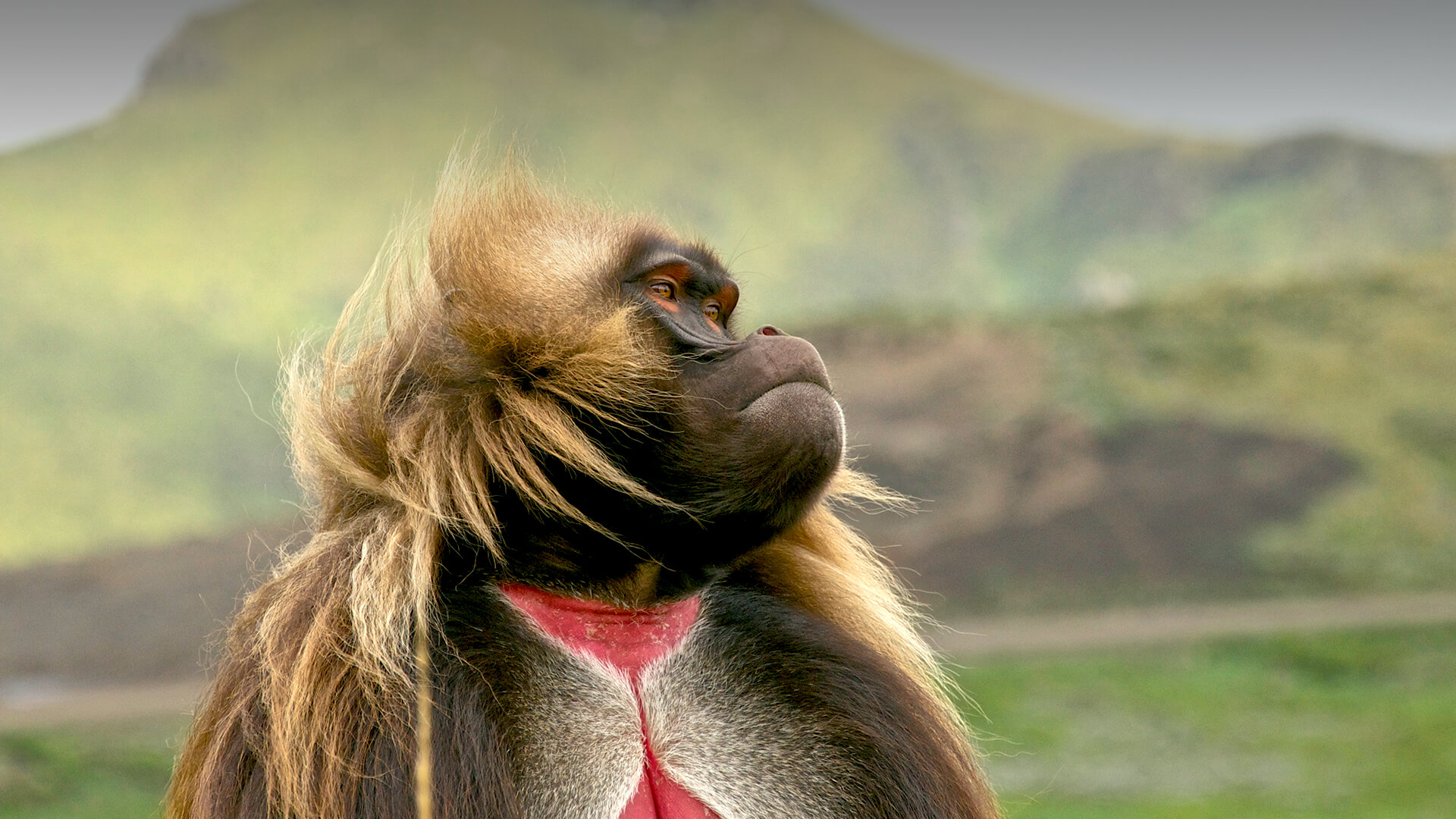
The gelada, also known as the bleeding-heart monkey or the gelada baboon, is a species of Old World monkey found only in the Ethiopian Highlands, living at elevations of 1,800–4,400 m (5,900–14,400 ft) above sea level. It is the only living member of the genus Theropithecus, a name derived from the Greek root words for “beast-ape”.
The gelada is large and robust, covered with buff to dark-brown, coarse hair, and has a dark face with pale eyelids. Its arms and feet are nearly black, and its short tail ends in a tuft of hair.
Adult males have a long, heavy cape of hair on their backs. Geladas are herbivorous, eating herbs, grasses, and other vegetation, and they can chew their food as effectively as zebra.
Geladas are primarily diurnal, sleeping on the ledges of cliffs at night and traveling to the tops of the plateaus to feed and socialize during the day. They live in multi-level societies, with the smallest being that of the family, a stable unit of one or a few males, two to ten females, and their dependent offspring.
Family units combine to form bands that travel together during the day, and sometimes geladas form large herds of up to 1200 individuals.
Snub-Nosed Monkey
The snub-nosed monkey is a group of Old World monkeys that make up the entirety of the genus Rhinopithecus. The genus is rare and not fully researched, and some taxonomists group snub-nosed monkeys together with the genus Pygathrix.
Snub-nosed monkeys live in Asia, with a range covering southern China (especially Tibet, Sichuan, Yunnan, and Guizhou) extending into the northern parts of Myanmar and Vietnam. They inhabit mountain forests up to elevations of more than 4,000 m (13,000 ft) and spend the majority of their life in the trees.
Snub-nosed monkeys are herbivorous, eating herbs, grasses, and other vegetation. They live together in very large groups of up to 600 members, splitting up into smaller groups in times of food-scarcity, such as in the winter.
Groups consist of many more males than females. They have territorial instincts, defending their territory mostly with shouts. They have a large vocal repertoire, calling sometimes solo while at other times together in choir-like fashion.
FAQS
1. What are Old World monkeys?
Old World monkeys are primates that are indigenous to Africa and Asia. They are larger in size, have more complex social structures, and longer snouts than New World monkeys.
2. How many types of Old World monkeys are there?
There are many types of Old World monkeys, including macaques, baboons, and langurs. In this article, we will explore 10 types of Old World monkeys.
3. Where can I find Old World monkeys?
Old World monkeys are found in Africa and Asia. They inhabit a variety of habitats, including savannas, woodlands, rainforests, and mountains.
4. What do Old World monkeys eat?
Old World monkeys are omnivorous, and their diet consists mainly of fruits and insects but also includes leaves, roots, and bird eggs.
5. How do Old World monkeys communicate?
Old World monkeys communicate with each other through a variety of vocalizations, including honks, rumbles, and hiccups. They also use facial expressions and body language to communicate.
6. Are Old World monkeys endangered?
Some species of Old World monkeys are endangered due to habitat loss and hunting. The kipunji, for example, is classified as an endangered species by the IUCN.
7. How can I learn more about Old World monkeys?
There are many resources available to learn more about Old World monkeys, including books, documentaries, and online articles.
Source: https://petstutorial.com
Category: Animals










